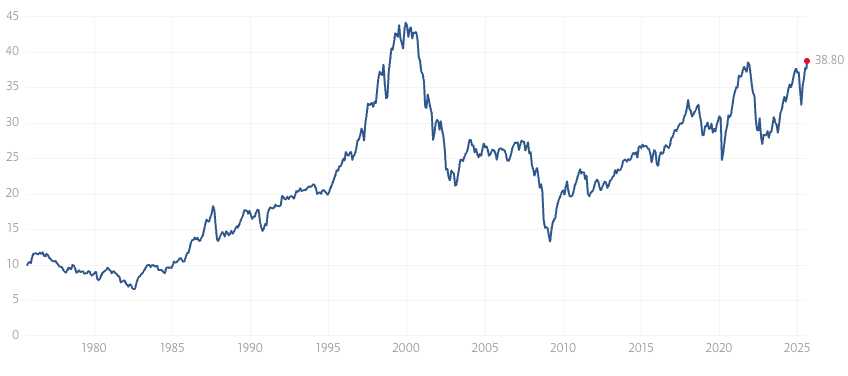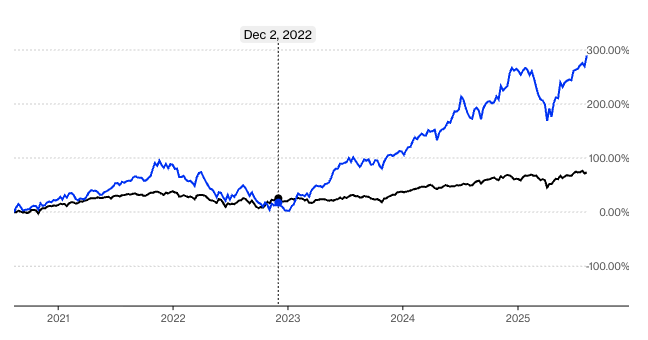What happens to the stock market when the AI bubble bursts?
Forget sentient robots or cures for cancer, AI’s single notable achievement so far has been to prop up a stock market that, in an alternate universe, would be buckling under the strain of tariffs, geopolitical tensions and flailing growth.
2025’s ongoing market rally seems to be running mostly on the fumes generated by the data centres powering the much-vaunted AI revolution.
But with the big tech stocks firmly on the AI bandwagon, hitting new all-time-highs and crazy valuations and dragging the rest of the market up with them, one can’t help but draw a parallel to the stock market’s last great tech-driven bubble.
And while I’m not the first to make the comparison between the dot-com era and the current AI era, it seems many investors are happy to pretend it doesn’t exist.

Like adding “.com” to your company name in 1999, or rebranding yourself a Web 3 company at the peak of the last crypto bubble in 2021, hitching your wagon to the AI boom has been enough in recent years to satiate investors desperate for any bullish catalysts they can find.
Regardless of what you think of its long-term impact, there’s a clear argument that AI, as it currently stands, is just the latest iteration of Silicon Valley’s ever-changing game of the emperor’s new clothes.
And, like with every other bubble in history, it’s only a matter of time before people start to notice he’s been naked this entire time.
The fact of the matter is that, effectively, no one is making any money from AI, and that doesn’t look like it’s going to change anytime soon.
Show me the money
While Meta, Google, Apple and others now offer their own generative AI models, only two dedicated AI companies account for the majority of revenue generated by LLMs - OpenAI and Anthropic.
Both make billions in revenue, but they’re both losing a lot more and have no clear path to profitability.
While OpenAI boasts 500 million weekly active users, it has only 15.5 million paying subscribers. This means the vast majority of its users actually cost the company money and will be hard to monetise if they can’t be convinced to become paying customers.
As Fat Tail’s Charles Ormond recently wrote for Livewire, OpenAI would need revenue numbers in the region of $200b in 5 years to justify its most recent rumoured valuation.
Given it’s currently doing $10b in annualised revenue, and still actually losing money, that seems a big mountain to climb.
The same appears true for the Mag 7.
As Edward Zitron explains in the provocatively titled “The Hater's Guide To The AI Bubble“, big tech is currently spending a lot on AI for very little return.
“If they keep their promises,” writes Zitron, “by the end of 2025, Meta, Amazon, Microsoft, Google and Tesla will have spent over $560 billion in capital expenditures on AI in the last two years, all to make around $35 billion.”
Right now, AI companies of all stripes are burning cash while their increasingly lofty predictions around AGI and the transformative effects of LLMs look increasingly unconvincing,
Ultimately, AI as a technology needs to pay the piper at some point.
Neither public nor private investors will be willing to throw money at AI companies indefinitely, especially if advancements slow down and it all becomes a case of diminishing returns, ongoing losses and dwindling users.
The early warning signs are already there.
Reception to OpenAI’s new flagship model, GPT-5, has been lukewarm.
It seems less like the next big step in AI advancement, and more a cost-cutting measure by OpenAI to stem the tide on expensive loss-leading queries from free users.
The problem for the stock market
The Mag 7 accounts for roughly one-third of the total value of the US equities market.
Since the release of the original ChatGPT on 30 November 2022, the Mag 7 returned 335.46%, according to Bloomberg’s Magnificent 7 Net Return Index (BM7N:IND).
By comparison, the rest of the S&P 500 (excluding the Mag 7) returned 39.4%.
The full S&P 500 index returned 158.3%, meaning the Mag 7 accounted for the overwhelming majority of the US market’s gains since the advent of consumer-facing AI.

So if things reverse for the Mag 7, as they would if the AI bubble bursts, things will suddenly be looking a lot less rosy for the rest of the market as well.
And the bubble may already be bursting.
According to analysis by Sevens Report Research’s Tom Essaye, semiconductor stocks are the canary in the coal mine for the AI trade.
In a recent note to clients, he explained how the PHLX Semiconductor Index (SOX), which tracks 30 semiconductor stocks, is still beneath its July 2024 highs, while the S&P 500 is up more than 10% in the same period.
"The takeaway here is that if AI remains the primary source of bullish optimism for a continued rally in the broader stock market in the months and quarters ahead, this market is in trouble and at risk of rolling over sooner than later as the SOX should still be leading the market higher like it was in 2024, not lagging considerably over the last 12 months," wrote Essaye.
"That divergence in index performance is meaningful, and if we see the SOX roll over in the weeks or months ahead and start selling off materially, the S&P 500 will almost certainly not be far behind."
As it so often does, the Mag 7 could also lead the charge on this front.
Most of Nvidia’s profit comes from selling chips to the other members of the Mag 7. If that spending dries up, not only will it serve as an indicator that Big Tech is abandoning AI, it will have obvious impacts on Nvidia’s profitability.
That could be a double whammy for the performance of the Mag 7, putting it (and the rest of the market) into a self-inflicted sell-off spiral.
Whether that means a crash on the scale of 2000, or even 2008, or more of a 2022-style correction becomes the biggest concern.
The trillion dollar question
There are a few potential saving graces.
The biggest players in AI are either literally some of the world’s largest corporations or privately owned companies with deep-pocketed investors.
Even if Meta, Google and others abandon (or dramatically scale down their AI investments), they’re still highly profitable companies with strong moats and reliable revenue streams.
If LLMs and generative AI also prove to be a flash in the pan, one could make the argument that divesting from AI could actually allow these companies to invest better in other more-profitable endeavours.
This could mean the stock market is unlikely to suffer the same scale of crash as it did following the dot-com bubble.
So while your Metas, Googles, Apples and Nvidias would likely sell off in any AI-driven slump, the immediate contagion for the wider market may be limited, beyond raising general jitters.
Alternatively, it could be the crisis that triggers a complete loss of faith in the current rally and the broader economy. Time will tell.
5 topics
1 contributor mentioned

